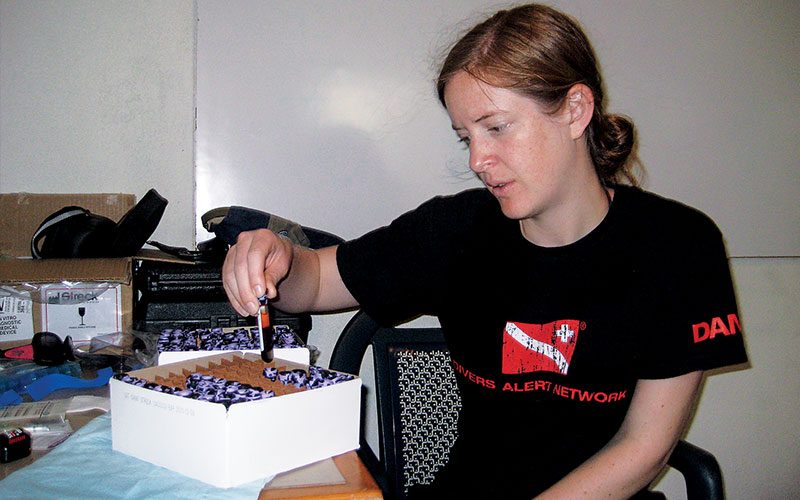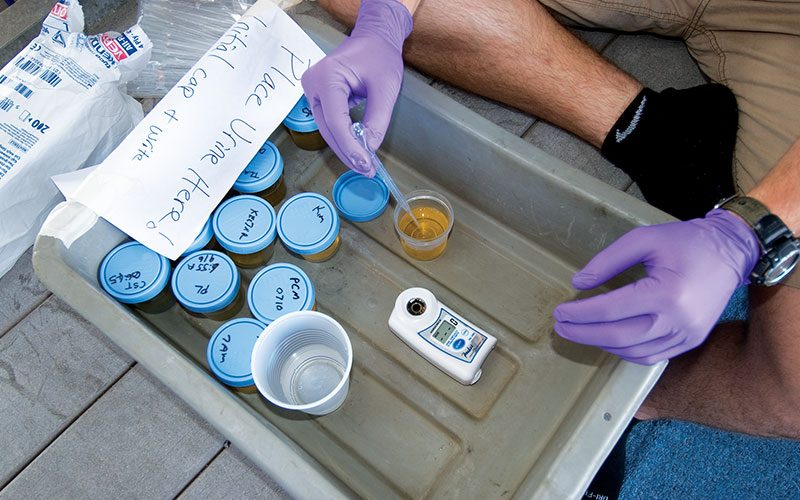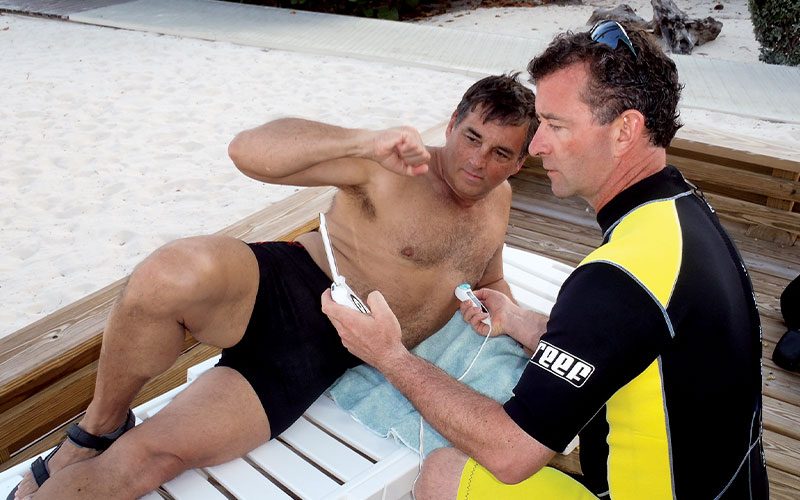The DAN® Medical Research department contributes to DAN’s mission by monitoring existing and emerging health and safety issues in recreational diving. It follows trends in diving practices and examines the causes, risk factors and mechanisms of injuries in diving. Perhaps of greatest interest to the diving public, DAN Research studies evidence-based treatment methods and the prevention of diving injuries.
Past Achievements
The history of research at DAN goes back 30 years. In that period, DAN-affiliated researchers have published more than 300 papers in scientific journals as well as dozens of special reports, scientific workshop proceedings and annual reports.
Collection of data on injuries and fatalities started in 1982 and resulted in the first DAN Annual Diving Report in 1983. After that, research expanded to include studies of risk factors and causes of injuries such as decompression illness, toxicity of hyperbaric gases, fatalities and more.
In 1985 DAN started a field study to learn about how recreational dive patterns affect risk of decompression sickness (DCS). Volunteer divers were examined with an ultrasound doppler monitor, which detected bubbles in the venous blood entering the right side of the heart and flowing toward the lungs. Doppler-detected bubbles were common during warm-water recreational dives, but there were no cases of DCS in the study group. More bubbles were found in warmer water, in males, in older divers, on deeper and repetitive dives and on the first day of diving.
At that time dive computers were just appearing on the market and there were concerns that their use might increase DCS risk. In 1988 DAN organized a workshop of dive-physiology experts to address the concerns about computers. Unlike decompression tables, which prescribed a maximum of two dives per day, computers enabled divers to do multiple dives. Again, this caused alarm among dive professionals, and DAN addressed that issue in a workshop on repetitive diving in 1989. It became obvious from these two workshops that the basic ingredient for risk assessment was missing. DAN was already receiving reports on injuries and fatalities (which, along with participation in diving, were on the rise), but there was no data about dive exposure (depth-time profiles, frequency of diving, total number of dives) that would enable calculation of accident rates or estimation of risk.
For that reason, DAN started a prospective study of dive exposure and outcomes: Project Dive Exploration (PDE). This study was possible thanks to dive-computer manufacturers who implemented modifications to their computers that would allow DAN to collect electronic records of dive profiles. Volunteer divers who participated provided additional information about their dives, health, dive history and health status after diving. So far, with contributions from DAN Europe, DAN has collected data from more than 250,000 dives. PDE data has provided an opportunity to study the effects of various dive patterns, dive environments and diver demographics on the risk of injury. This data is being analyzed, and publications are pending.
For seven years DAN conducted experimental studies with volunteer divers resting in a dry hyperbaric chamber at the Duke Center for Hyperbaric Medicine and Environmental Physiology to determine a safe time to wait to fly after diving. This data has been used to update the guidelines for flying after diving (FAD). The other phase of FAD study — looking at how the delay is affected by exercise and immersion in water — concluded in December 2012.

Analysis of diving injuries over the years has shown that recreational divers often dive in remote places and that travel time to places where they can receive recompression treatment may be very long. In 2004 DAN organized the workshop “Management of Mild or Marginal Decompression Illness in Remote Locations,” which provided guidance for optimal treatment in such cases.
Diabetes continues to become increasingly prevalent in the general population, and it affects some divers and people who would like to become divers. DAN conducted several field studies with divers who had diabetes and documented how diving affected those with the disease. In 2005 DAN’s Diabetes and Recreational Diving workshop considered the available evidence and procured specific guidelines for safe diving for some divers with diabetes.
Breath-hold diving has become more popular in recent decades, which has resulted in an increased incidence of injuries. DAN began monitoring breath-hold injuries in 2000 and in 2006 convened experts with relevant experience to discuss the safety of breath-hold diving. The findings provided guidelines for safe breath-hold diving practices and outlined areas for future research.
In 2005 DAN undertook a major analysis of nearly 1,000 dive fatalities reported in the preceding 10 years. The data showed an obvious increasing trend of fatalities in technical and, especially, rebreather diving. The Technical Diving Conference in 2008 summarized current knowledge about the physiology and medicine of extreme diving and made suggestions for possible improvements in current practices.
Also in 2008, DAN Research published two major papers about the causes, incidence and risk factors of diving fatalities: “Most Common Causes of Diving Fatalities” and “Fatality Rates Among DAN Members.” The findings presented in these papers along with similar data from elsewhere in the world were discussed extensively during the Recreational Diving Fatalities workshop DAN organized in 2010. The consensus statement produced by the attendees of the workshop pointed out a need to address the most common causes of injuries through training and dive operations. Health requirements were reviewed and edited to better address cardiac causes of death.
In 2012, in cooperation with the American Academy of Underwater Sciences and PADI and with broad support from the diving industry, DAN organized Rebreather Forum 3 (RF3). This conference mobilized the diving community to intensify efforts to foster a culture of safety at all levels of training and in all diving situations. The forum endorsed the DAN Online Incident Reporting System (www.DAN.org/IncidentReport) as a means to improve reporting of incidents. RF3 also stressed the need for a predive checklist to become commonplace in recreational and technical diving.
Current Safety Issues in Recreational Diving

Prevention of injuries and fatalities remains a primary concern of DAN Research. The problem is compounded by the aging population of recreational divers, which is a reflection of an aging general population combined with relatively fewer young people willing to commit to diving (many engage in diving occasionally). Explore-diving opportunities like those popular at many resorts cater to such occasional divers. On the other hand, some divers engage in more challenging diving practices such as technical diving, cave diving and breath-hold diving, which expose them to different sets of risks. Here is an overview of our ongoing studies and our plan for addressing these issues.
Health & Diving Practices Survey
This study indicated that DAN members are healthier and wealthier than the general population in the U.S. The proportion of divers with known cardiac problems is small, but there are many who have known risk factors for cardiac disease such as smoking, physical inactivity, obesity, high blood cholesterol and high blood pressure. The best strategies for mitigating the associated risks are the same as for nondivers: adopting a healthy lifestyle; controlling cholesterol, blood pressure and weight; and regularly engaging in physical activity. More research is needed to learn how diving may affect these divers and to identify those whose risk could be increased due to diving.
Patent Foramen Ovale (PFO) & Diving
The risk of DCS may be increased in divers with a PFO. A retrospective review of statistics indicates there may be an association between PFO and DCS, but the risk of DCS is small in all divers (whether or not they have a PFO). Some divers with PFOs who suffered multiple episodes of DCS decide to quit diving, others choose to dive more conservatively, and some others choose to undergo a medical procedure that closes the PFO to mitigate their risk. The procedure of closure includes a small risk of complications, but a true risk-benefit analysis had never been conducted. In cooperation with Dr. Doug Ebersole of Watson Clinic in Florida, we undertook a five-year study to compare the safety of divers who underwent PFO closure and those who continue diving without it. There are currently 60 participants in the study, and enrollment is still open.
Nitrox Versus Air in Open-Circuit Diving
Nitrox has been widely used in the past few decades. Despite some concerns raised in the early stages of this practice, injury and fatality statistics did not show any increase due to the use of nitrox. There is a general consensus that replacing air with nitrox and diving at the same depth for the same duration provides an additional margin of safety (due to a reduced partial pressure of nitrogen and more oxygen). However, using nitrox to extend dive time without incurring mandatory decompression or diving to the equivalent air depth was never explicitly tested in recreational diving.
We compared postdive bubble grades in divers breathing air at 60 feet of seawater with divers breathing nitrox at the equivalent depth of 70 feet.Both depths exposed divers to the same partial pressure of nitrogen. The overall bubble grades were similar, but the high bubble grades and, probably, the greater risk of DCS were more common in the divers breathing air. This small favorable effect may have been due to the higher partial pressure of oxygen in nitrox. While this suggests a benefit of nitrox diving, we continue research by analyzing circulating microparticles, small fragments shed from cells, which may be in some way implicated as mechanisms of DCS.
Extreme Diving Field Studies

Technical divers use mixed gases in open- and closed-circuit diving and regularly exceed depths of 200 feet. This exposes their bodies to large loads of dissolved inert gases and imposes significant decompression obligations. Most decompression tables and algorithms used in dive computers have not been systematically tested. Since an observational study during dives on the Britannic in 2006, we have conducted monitoring of technical divers on many occasions and in various diving activities. The main tool in our research is echocardiography, which enables imaging of bubbles that pass through heart. So far we have conducted several thousand echocardiograms and documented various degrees of bubbles.
We shared our findings with the tested divers, and they often modified their dive profiles (by decreasing bottom time, adding decompression time or using more oxygen) to keep their postdive bubble grades and their risk of DCS low. We also conducted basic anthropometric measurements, lung-function tests and evaluations of participants’ fitness. A number of divers have provided blood samples for studies of microparticles and markers of inflammation and cell injuries. These studies continue, and data are still being examined. Some preliminary findings were presented in the Journal of Applied Physiology.
Oxygen Toxicity & Erectile Dysfunction Drugs
PDE-5 inhibitors are a group of drugs that includes Cialis and Viagra and are used for the treatment of erectile dysfunction (ED) as well as some other indications such as enlarged prostate. PDE-5 inhibitors achieve their desired effects by dilating arteries and increasing blood flow. Most of that effect is limited to targeted areas, but circulation in the brain may also be affected to a lesser degree. Theoretically, this could increase the risk of oxygen toxicity. Indeed, DAN was called by a diver who suffered seizure activity during a dive while he was using a drug for ED. This started a discussion among researchers, and eventually a study was initiated by Dr. Ivan Demchenko and coworkers at Duke University.
This experimental study showed that animals treated with PDE-5 take less time to develop oxygen seizures when exposed to hyperbaric oxygen. The lesson learned for divers is to not combine PDE-5 drugs with high partial pressure of oxygen. Various preparations of PDE-5 stay in the blood for various lengths of time, and divers using these drugs should be aware of the half-life times of the specific drug they use.
Effects of Pseudoephedrine (PSE) on Oxygen Toxicity
PSE is an active component in many over-the-counter (OTC) drugs used to combat congestion from common colds or allergies. Among the most well known of these drugs is Sudafed, which is widely used among divers. There were concerns that it may not be safe to use Sudafed while diving with nitrox or other hyperoxic gases, but these concerns were never addressed in experimental studies.
DAN sponsored a study by Dr. Dean Jay of the University of South Florida. The study used an animal model and showed that normal doses of PSE should not increase the risk of oxygen toxicity, but very high doses (which could be inadvertently achieved by divers using multiple OTC drugs containing PSE at the same time) could increase the risk. The study also confirmed the notion that some individuals at some times may be more vulnerable to oxygen toxicity than the average diver. To learn more about oxygen toxicity, see Expert Opinions in this issue of Alert Diver.
Effects of Predive Checklist Use on Diving Mishaps
In the summer of 2012 DAN conducted a study on the effect of predive-checklist use on the incidence of diving mishaps. The study was conducted in four different locations with the help of DAN summer interns. More than 1,000 divers volunteered for the study. Findings indicate that the incidence of mishaps (such as out-of-air emergencies, buoyancy problems, buddy separation, exceeding planned depths or time) was reduced in divers who received predive checklists before diving in comparison with divers who were not given checklists but who could have used their own. While most training agencies teach the use of predive checklists, it appears that many divers do not use them in unsupervised diving. We hope the demonstration of efficacy this study provides will help support a campaign for an improved culture of safety in diving that includes the use of predive checklists. Checklists are effective tools for preventing human errors and reducing injuries and fatalities; to read more about this study, see Safety 101 in this issue of Alert Diver.
Studies in 2013

Several new lines of research will be explored this year. The first will be the prevalence of increased muscular mass of the left heart (known as left ventricular hypertrophy or LVH) in divers and its correlation with the incidence of heart-rhythm abnormalities during diving. This study will use echocardiography to establish LVH and continuous electrocardiogram (Holter monitoring) during diving to monitor for arrhythmias.
DAN is also working on studies that will address physical fitness for diving in greater detail; both the requirements and the methods of evaluation will be reviewed.
Another study will address the possible effects of scuba and breath-hold diving on brain function in divers who did not exhibit obvious signs of injury. For this study, we will use a digital pen and a clock-drawing test — a test with a long history in clinical medicine. In combination with a digital pen, this test becomes a very sensitive and valuable tool in the early detection of diseases such as Alzheimer disease. It is sensitive enough to detect minor and transitory changes in executive brain functions that could be occurring after some extreme dives.
Through this research, DAN continues its ongoing mission of promoting dive safety and helping divers in need.
Cooperation
DAN’s core mission is to improve dive safety. We continually enhance the caliber and capacity of our medical services and research through collaborations with leading institutions and research groups. In recent years these include Duke University, University of Pennsylvania, University of California at San Diego, University of Split (Croatia), University of South Florida and the Watson Clinic.
© Alert Diver — Q1 Winter 2013